The following is an excerpt from the Tattoo History Source Book:
Polynesian Tattoos
Polynesian tattooing, as it existed before
the arrival of Europeans in the South Pacific, was the most intricate and
skilful tattooing in the ancient world. It had evolved over thousands of years
and was characterized by elaborate geometrical designs which were often renewed,
and embellished throughout the life of the individual until they covered the
entire body.
It was in Tonga and Samoa that the Polynesian tattoo developed into a highly
refined art. Tongan warriors were tattooed from the waist to the knees with a
series of geometrical patterns, consisting of repeated triangular motifs, bands,
and areas of sold black. Priests who had undergone a long period of training and
who followed strictly prescribed rituals and taboos during the process executed
the tattooing. For the Tongon, the tattoo carried profound social and cultural
significance.
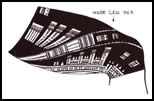 In ancient Samoa, tattooing played an important role in both religious ritual
and warfare. The tattoo artist held a hereditary and highly privileged position.
He customarily tattooed young men in groups of six to eight, during a ceremony
attended by friends and relatives. The Samoan warrior's tattoo began at the
waist and extended to just below the knee.
In ancient Samoa, tattooing played an important role in both religious ritual
and warfare. The tattoo artist held a hereditary and highly privileged position.
He customarily tattooed young men in groups of six to eight, during a ceremony
attended by friends and relatives. The Samoan warrior's tattoo began at the
waist and extended to just below the knee.
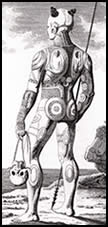 Samoan women were tattooed as well, but female tattooing was limited to a
series of delicate flower-like geometrical patterns on the hands and lower part
of the body.
Samoan women were tattooed as well, but female tattooing was limited to a
series of delicate flower-like geometrical patterns on the hands and lower part
of the body.
About 200 AD, voyageurs from Samoa and Tonga settled in the Marquesas. Over a
period of period of more than a thousand years, one of the most complex
Polynesian cultures evolved. Marquesan art and architecture were highly
developed and Marquesan tattoo designs, which in many cases covered the whole
body, were the most elaborate in Polynesian.
By 1,000 AD the Polynesian peoples had colonized most of the habitable
islands east of Samoa. Distinctive cultural traits evolved in each of the island
groups and so did unique languages, myths, arts and tattoo styles. Polynesian
tattooing is briefly mentioned in European ship's logs dating from the 17th and
18th centuries, but it wasn't until Captain Cook, in 1769 that is was described
in detail by Cook's naturalist, Joseph Banks.
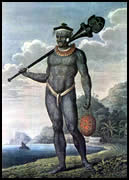 In August of 1769, Banks describes how tattoos were produced:
In August of 1769, Banks describes how tattoos were produced:
"The color they use is lamp black which they prepare from the smoke of a kind of
oily nuts used by them instead of candles. This is kept in coconut shells and
mixed with water occasionally for use. Their instruments for pricking this under
the skin are made of bone and shell, flat, the lower part of this is cut into
sharp teeth from 3 to 20 according to the purpose into the skin so deep that
every stroke is followed by a small quantity of blood, or serum at least, and
the part so marked remains sore for many days before it heals."
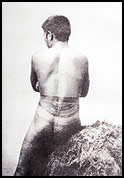 Sir Joseph Banks was the first European who speculated as to the motive for
tattooing among the natives of Polynesia. During his visit to Tahiti in 1769, he
wrote: "What can be sufficient inducement to suffer so much pain is difficult to
say; not one Indian (though I have asked hundreds) would ever give me the least
reason for it; possibly superstition may have something to do with it. Nothing
else in my opinion could be a sufficient cause for so apparently absurd a
custom."
Sir Joseph Banks was the first European who speculated as to the motive for
tattooing among the natives of Polynesia. During his visit to Tahiti in 1769, he
wrote: "What can be sufficient inducement to suffer so much pain is difficult to
say; not one Indian (though I have asked hundreds) would ever give me the least
reason for it; possibly superstition may have something to do with it. Nothing
else in my opinion could be a sufficient cause for so apparently absurd a
custom."
Members of Cook's crew were the first Europeans to acquire Polynesian
tattoos, and the fad quickly spread in the British Navy as sailors returned home
with tattoos as souvenirs of their travels to distant lands. Sailors also
learned the technique from Polynesian artists, practiced it onboard ship, and
later retired to establish tattoo parlors in European port cities. Tattooing is
the only form of Polynesian art that has been widely adopted and imitated by
westerners.
Tattoo Museum Bibliography, Resources and Links
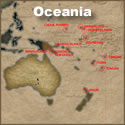 See all Oceanic Tattoo Culture Articles here
See all Oceanic Tattoo Culture Articles here
Additional Resources
Skin
Stories - The Art and Culture of Polynesian Tattoo -- Skin Stories is an anthology of stories and stunning images gathered from the hot spots of Pacific tattoo: from the steaming landscape of Rotorua in New Zealand to the vibrant gathering of the first international tattoo convention in Apia, Samoa; from the terraced, lush taro fields of Maui to the golden beaches of O'ahu and California.
Meanings of Polynesian Tribal Tattoo Designs - Online Dictionary
TATAU:
THE TAHITIAN REVIVAL -- Tricia Allen's 1998 article on the revival
of the Tahitian tattoo
Tatau,
Polynesian tattoos, the renaissance -- In traditional Polynesian society,
the art of tatau (tattoos) had a high degree of sophistication in design as well
as within its profound symbology. Condemned as pagan and forbidden for over 160
years, this extraordinary art could have well disappeared if it weren't for a
spectacular renaissance that began in the 1980s. Now, at the beginning of the
21st century, tatau has once again found its place in Polynesian society.
NEXT >>
Borneo
